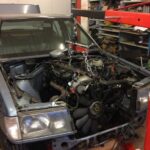Cummins Code 3135, along with several other fault codes (1883, 1921, 1922, 1981, 2639, and 3168), can indicate an issue with the Diesel Particulate Filter (DPF) differential pressure sensor orientation. This issue stems from an incorrect installation that allows moisture to accumulate in the sensor and its tubes. Trapped moisture interferes with pressure readings, triggering these fault codes. This article outlines the problem, diagnostic steps, and the necessary corrective actions for various DPF configurations.
Understanding the Problem: Moisture and Sensor Malfunction
The root cause of Cummins code 3135 and related codes often lies in the upward slope of the DPF pressure sensor tubes. This incorrect orientation prevents moisture from draining, leading to its accumulation within the sensor and connecting tubes. In freezing temperatures, this trapped moisture can freeze, further disrupting sensor function and triggering fault codes. Accurate pressure readings are crucial for proper DPF operation, and compromised readings due to moisture can lead to performance issues and increased emissions.
Diagnosing Cummins Code 3135
The first step in addressing Cummins code 3135 is to verify its presence. Utilize the INSITE™ electronic service tool to read active or inactive fault codes. If any of the aforementioned codes are present, visually inspect the DPF differential pressure sensor and its tubing for incorrect orientation. Look for upward slopes that could trap moisture. If the sensor appears correctly installed, consult published troubleshooting guides for alternative causes.
Resolving the Issue: Ensuring Proper Sensor Orientation
The solution involves ensuring a continuous downward slope of the DPF differential pressure sensor tubes, regardless of whether the DPF is mounted horizontally or vertically. A recommended 10-degree downward angle facilitates proper drainage.
Adjusting Horizontally Mounted DPF Sensors:
- Canister-Mounted Sensors: Loosen the sensor bracket strap, allowing the tubes to reposition the bracket. Mark the bracket’s position, then rotate it upwards to achieve the desired 10-degree down angle. Adjust port fittings and tube retention clips accordingly. Shorten tubes if necessary, ensuring equal lengths.
- Remotely-Mounted Sensors: Adjust port fittings for a 10-degree down angle. Shorten tubes as needed, maintaining equal lengths.
Adjusting Vertically Mounted DPF Sensors:
- Canister-Mounted Sensors: Adjust downstream sensor port fittings to a 5-degree down angle. Move the sensor bracket upwards to achieve a 5-degree down angle on the downstream tube. Shorten the upstream tube if necessary.
General Considerations:
- Tube Shortening: When shortening tubes, ensure clean cuts and remove equal lengths from both tubes. Refer to the appropriate service manual for detailed procedures (Procedure 011-046 in Section 11).
- Temperature Coupling Alignment: Ensure alignment of temperature couplings on the DOC inlet (T1) and the DPF (T2). If misaligned, loosen band clamps and rotate the DPF canister.
Conclusion
Correcting the DPF differential pressure sensor orientation is crucial to resolving Cummins code 3135 and associated fault codes. By ensuring a downward slope of the sensor tubes, moisture accumulation is prevented, leading to accurate pressure readings and optimal DPF performance. Following the outlined procedures for various DPF configurations will help address this issue effectively. Always consult the relevant Cummins service manual for detailed instructions and torque specifications.
